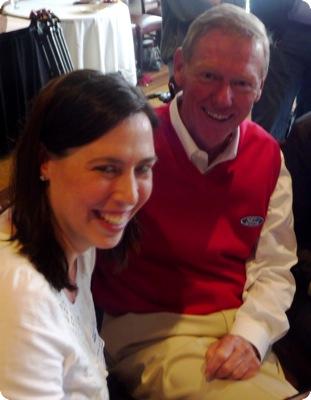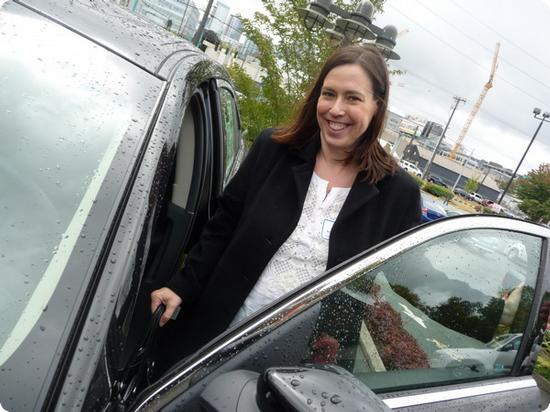My Meeting With Ford CEO Alan Mulally and Questions on Child Safety in Cars
During Labor Day weekend I was invited to a local media brunch with Alan Mulally, CEO of Ford Motors as a part of the effort to launch the new Ford Taurus. If you want to see me looking serious and taking notes, click here

I sat alongside journalists who have been covering autos for years and instead of asking about unions, fuel efficiency, company finances or any of a number of other worthy questions, I asked about what seemed most relevant to my life and to my readers... What is Ford doing to make our children safer when they travel in Ford vehicles.
According to the CDC motor vehicle accidents are the leading cause of death among children in the United States, so even small improvements can make a big difference in the number of fatalities each year.
Mr Mulally's answer focused on what Ford is doing to help drivers avoid accidents in the first place. Optional features on the new Ford Taurus alert the driver to an approaching vehicle in the car's blind spot, and to difficult-to-see cross traffic when the Taurus is backing up. These innovative features seem like they could help avoid some of the common causes of accidents.

It is also important that each child be seated in a correctly installed child safety seat. Child safety seats have proven so effective that they are mandatory in all 50 states. In Washington State, where I live, child restraints are required until a child reaches age 8. I will be installing, uninstalling, and re-installing car seats for a total of almost 13 years! Each time one child outgrows their seat, I revisit this issue, sometimes re-arranging and re-installing all of their seats.
It sounds easy enough, but according to the National Highway Traffic Safety Administration, three out of four car seats are used incorrectly. Properly installing a car seat can require reading both the car seat installation instructions and the car's owner's manual as well as a number of "tricks of the trade." To make things even more complicated, not every seat fits in every car - meaning that a parent might spend hours trying to properly install a seat only to return it, purchase a new seat, and try again.
It's so difficult, that the government has asked that by 2011 car manufacturers test and recommend specific car seat models that work well in individual vehicles. Some car manufacturers, including Nissan already test and recommend specific seats, while others, like Volvo sell booster seats designed specifically for their cars.
I followed up with Kelly Adams-Campos in Ford's Automotive Safety Office (Ms. Adams-Campos is also a registered car seat tech in her off hours) to understand what Ford is doing to make car seat installation easier and more reliable for their customers.
According to Ms Adams-Campos, the company has simplified installation by making it possible to use LATCH in the middle seat position with some car seats. However, the company does not test or recommend specific car seat models.
When I asked about the government's new program, I was told that the company does not have plans to test specific seats or make recommendations, because, according to Ford, it is not a good use of Ford's time and resources. Instead, the company refers customers to the website CarSeatData.org where parents share information about what worked for them.
As a car-owner and a parent, I'd love to see auto companies work together with car-seat manufacturers to make it easier to install seats properly. A list of seats that work well (and seats that don't) seems like a great first step. Do you think car manufacturers should do more or do you think that researching, choosing and installing the correct car seat is easy enough already? What would you like to see auto companies do to help make children safer? Share your thoughts in comments, and I will make pass them on to Ford.
2 comments |
Posted on September 30, 2009 |
 Save to del.icio.us
Save to del.icio.us


Comments
Becky C. on September 30, 2009 at 10:11 p.m.
I think car companies should absolutely do more. I only found out after purchasing my car that Subaru doesn't recommend placing a child seat in the center of the rear seat. Annoying. And I couldn't really imagine a parent going through the hassle of returning a car seat that didn't quite work right in a car, returns at most stores are pretty painful if you've broken into a box.
I do think the onus should be on car and seat manufacturers to determine if and where a seat can be installed safely, and that info should be easily available, not buried on pg 167 of the owner's manual.
Linda on October 8, 2009 at 7:03 a.m.
I agree that it's not a good use of Ford's time to make a list of seats that fit well in their vehicles. Carseat models are changing constantly.
What they can and should do is make installation easier for their vehicles. Having a center LATCH position is a great first step. But how about having a LATCH position in each and every rear-seating spot in the vehicle, so that families can choose where to put their children? (In most SUV's and minivans, there are two middle-row LATCH spots and one (center) 3rd-row spot. My Toyota Sienna has five LATCH positions, making it unique, and offering me greater flexibility in installing carseats.)
Vehicle design can help carseat installation, no matter which seat is used. Often, a "hump" in the center of a vehicle backseat makes it impossible to get a good fit, whether using LATCH or seatbelts. The permanent, forward-reaching headrests can make installation of a tall carseat or high-back booster difficult. Stiff seatbelt stalks or hard-to-reach lower-anchor and tether-anchor spots make installation difficult. Absence of a place to anchor the d-ring of a rear-facing tether is a problem in some vehicles as well.
Personally, I would love to see any manufacturer make a true six-passenger full-size pickup truck that includes a shoulder belt and headrest in the front seat, or a hybrid vehicle that will fit seven or eight passengers while still having room for some cargo.
Those are just some of my ideas. You asked great questions when given the opportunity, Debbie!